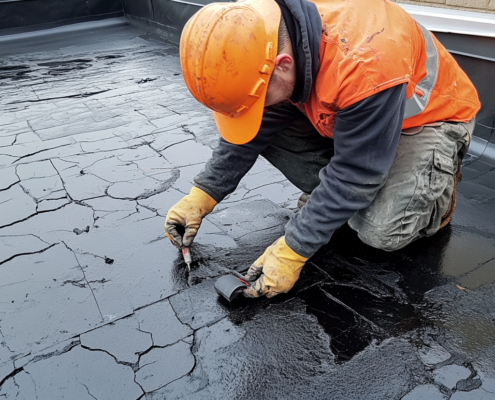Flat Roof Waterproofing: Key Techniques and Tips for Ontario Buildings
Flat roof waterproofing is crucial for the longevity and performance of commercial and residential buildings, particularly in climates like Ontario’s, where rain and snow can quickly cause damage to unprotected roofs. Without proper waterproofing, a flat roof can be prone to leaks, mold growth, and structural damage.
This comprehensive guide will walk you through everything you need to know about flat roof waterproofing, including the different methods, benefits, common challenges, and how to ensure your flat roof remains safe, dry, and durable for years to come.
Why Flat Roof Waterproofing is Essential
Flat roofs are more susceptible to water pooling and leaks than sloped roofs, making effective waterproofing essential. Without a solid waterproofing system, even a minor leak can cause major damage to the building’s interior, structure, and contents. Here are a few reasons why flat roof waterproofing should be a priority:
- Prevents Water Damage
Waterproofing ensures that water doesn’t seep into the roof structure, preventing damage to insulation, beams, and the building’s interior. - Increases Roof Longevity
By creating a protective barrier, waterproofing extends the life of your flat roof and reduces the need for costly repairs. - Maintains Energy Efficiency
A well-maintained waterproof layer helps maintain the roof’s thermal performance, reducing the amount of energy needed to heat or cool the building. - Protects from Harsh Weather
Ontario experiences extreme weather, from heavy rain to snow and freezing temperatures. Flat roof waterproofing shields the roof from these weather conditions.
Common Flat Roof Waterproofing Methods
Several flat roof waterproofing techniques are available. The best option for your building will depend on various factors, such as roof type, climate, budget, and desired lifespan. Here are the most commonly used waterproofing methods for flat roofs:
1. EPDM (Ethylene Propylene Diene Monomer) Membrane
EPDM is a rubber-based membrane that’s widely used for flat roof waterproofing. It’s known for its durability and flexibility, making it ideal for harsh weather conditions.
- Pros: Highly durable, UV resistant, low maintenance, and cost-effective.
- Cons: Black color may absorb heat, increasing cooling costs in some areas.
2. TPO (Thermoplastic Olefin) Membrane
TPO is another popular single-ply roofing membrane, known for its energy efficiency and ease of installation. It reflects heat, making it an excellent choice for buildings that need to minimize energy consumption.
- Pros: Reflects heat, energy-efficient, and lightweight.
- Cons: Less durable than EPDM in some conditions, prone to damage from punctures.
3. Modified Bitumen Membrane
Modified bitumen roofing is made by combining asphalt with other materials like rubber or plastic. It’s a versatile option for flat roofs that require a strong, waterproof layer.
- Pros: Strong, durable, and highly waterproof.
- Cons: Can be more expensive than other options and requires professional installation.
4. Liquid Waterproofing Systems
Liquid-applied membranes are used to create a seamless waterproof barrier on flat roofs. These systems are typically applied using rollers or spray equipment and form a strong, flexible layer of protection.
- Pros: Seamless application, ideal for complex roof shapes, quick to install.
- Cons: Requires expert application to ensure an even and consistent layer.
5. Green Roofing (Vegetated Roofs)
Green roofs are a more eco-friendly option, using plants and soil as a form of insulation and waterproofing. These roofs are suitable for flat roofs in urban areas and provide additional environmental benefits.
- Pros: Provides natural insulation, reduces stormwater runoff, and contributes to biodiversity.
- Cons: Expensive to install and maintain.
Signs That Your Flat Roof Needs Waterproofing
Even with proper installation, flat roof waterproofing systems can wear down over time. Look for the following signs that your roof may need waterproofing attention:
- Visible Leaks
Water stains on the ceiling or walls are often a clear sign that your roof is leaking. - Cracks or Blisters in the Membrane
If the membrane is cracked, bubbling, or blistering, it’s no longer effectively waterproofing the roof. - Pooling Water
Standing water on your flat roof can lead to leaks and deterioration of the waterproofing layer. - Age of the Roof
If your roof is more than 15 years old, it’s a good idea to have it inspected for any signs of wear or damage.
How to Maintain Flat Roof Waterproofing
Maintenance is key to ensuring your flat roof waterproofing system continues to perform optimally. Here are some essential maintenance tips:
- Inspect Regularly: Check your roof for signs of damage, wear, or debris buildup at least twice a year.
- Clear Debris: Remove leaves, twigs, and other debris from the roof to prevent water from pooling.
- Repair Damage Quickly: If you notice cracks, punctures, or other damage, repair them immediately to prevent water intrusion.
- Ensure Proper Drainage: Ensure that your roof’s drainage system is clear and functioning properly to avoid water buildup.
FAQ: Frequently Asked Questions About Flat Roof Waterproofing
1. How long does flat roof waterproofing last?
The lifespan of a waterproofing system depends on the material used. EPDM and TPO membranes can last 20-30 years with proper maintenance, while modified bitumen systems can last 15-20 years. Liquid waterproofing systems may need reapplication every 10-15 years.
2. Can I install waterproofing myself?
While some liquid waterproofing systems can be DIY-friendly, it’s generally recommended to hire professionals for flat roof waterproofing. Improper installation can result in leaks or an ineffective waterproof barrier.
3. How much does flat roof waterproofing cost?
The cost varies depending on the size of the roof, the material chosen, and the complexity of the installation. On average, you can expect to pay between $4 and $10 per square foot for high-quality waterproofing systems.
Why Choose Commercial Flat Roofs for Your Waterproofing Needs?
At Commercial Flat Roofs, we specialize in designing and installing high-quality flat roof waterproofing systems for both commercial and residential buildings in Ontario. Our experienced team ensures that your roof remains protected against water damage, extending its lifespan and improving energy efficiency.
Ready to protect your flat roof with reliable waterproofing? Contact us today for a free consultation.








